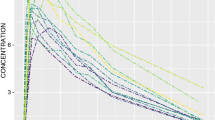Abstract
In a seminal article on population pharmacokinetic modeling, researchers demonstrated how means and variances of pharmacokinetic parameters for a patient population could be inferred from sparse data collected under conditions of routine patient care. But they also identified 4 potential concerns about their methodology: unobserved confounding variables may bias the inferences; conditions under which data are collected may lead to inaccuracies of reporting or recording; correlations among important predictor variables may reduce statistical efficiency; and costs cannot be controlled by principles of study design. Experiences are reviewed that related to those potential disadvantages. A method is presented for diagnosing the possible presence of confounding. A model is constructed and applied that captures the influences of data inaccuracies. An example of selecting from among correlated covariates is summarized. Finally, a methodology for optimal study design is reviewed and applied to an example.
Similar content being viewed by others
References
Sheiner LB, Rosenberg B, Marathe VV. Estimation of population characteristics of pharmacokinetic parameters from routine clinical data.J Pharmacokinet Biopharm. 1977;5:445–479.
Sheiner LB, Rosenberg B, Melmon KL. Modelling of individual pharmacolinetics for computer-aided drug dosage.Comput Biomed Res. 1972;5:411–459.
Mentre' F, Burtin P, Merle' Y, van Bree J, Mallet A, Steimer J-L. Sparse-sampling optimal designs in pharmacokinetics and toxicokinetics.Drug Inf. J 1995;29:997–1019.
Beal SL, Sheiner LB, eds. NONMEM Users Guides. Hanover, MD: GloboMax, LLC; 1989-1998.
Available at: http://www.uq.edu.au/pharmacy/sduffull/popt.htm. Accessed date: July 19, 2005.
Retout S, Duffull S, Mentre' F. Development and implementation of the population Fisher information matrix for the evaluation of population pharmacokinetic designs.Comput Methods Programs Biomed. 2001;65:141–151.
Retout S, Mentre' F. Further developments of the Fisher information matrix in nonlinear mixed effects models with evaluation in population pharmacokinetics.J Biopharm Stat. 2003;13:209–227.
Retout S, Mentre' F. Optimisation of individual and population designs using Splus.J Pharmacokinet Pharmacodyn. 2003;30:417–453.
Green B, Duffull SB. Prospective evaluation of a D-optimal designed population pharmacokinetic study.J Pharmacokinet Pharmacodyn. 2003;30:145–161.
Harrel F. Regression Modeling Strategies with Applications to Linear Models, Logistic Regression, and Survival. New York: Springer, 2001;56–60.
Mandema JW, Verotta D, Sheiner LB. Building population pharmacokinetic-pharmacodynamic models. I. Models for covariate effects.J Pharmacokinet Biopharm. 1992;20:511–528.
Jonsson EN, Karlsson MO. Automated covariate model building with NONMEM.Pharm. Res. 1998;15:1463–1468.
Kowalski KG, Huntmacher MM. Efficient screening of covariates in population models using Wald's approximation to the likelihood ratio test.J Pharmacokinet Pharmacodyn. 2001;28:253–275.
Available at: http://www.cognigencorp.com/nonmem/nm/ 99sep 152004.html. Accessed date.
Available at: http://www.cognigencorp.com/nonmen/nm/ 99nov212000.html.Accessed date.
Cockroft DW, Gault MH. Prediction of creatinine clearance from serum creatinine.Nephron. 1976;16:31–42.
Girard P, Sheiner LB, Kastrissios H, Blaschke TF. Do we need full compliance data for population pharmacokinetic analysis?J Pharmacokinet Biopharm. 1996;24:265–282.
Vrijens B, Goetghebeur E. The impact of compliance in pharmacokinetic studies.Stat Methods Med Res. 1999;8:247–262.
Vrijens B, Goetghebeur E. Electronic monitoring of variation in drug intakes can reduce bias and improve precision in pharmacokinetic/pharmacodynamic population studies.Stat Med. 2004;23:531–544.
Lu J, Gries J-M, Verotta D, Sheiner LB. Selecting reliable pharmacokinetic data for explanatory analyses of clinical trials in the presence of noncompliance.J Pharmacokinet Pharmacodyn. 2001;28:343–362.
Mu S, Ludden TM. Estimation of population pharmacokinetic parameters in the presence of non-compliance.J Pharmacokinet Pharmacodyn.. 2003;30:53–81.
Karlsson MO, Sheiner LB. The importance of modeling interoccasion variability in population pharmacokinetic analyses.J Pharmacokinet Biopharm. 1993;21:735–750.
Wang W, Hsuan F, Chow S-C. The impact of patient compliance on drug concentration profile in multiple doses.Stat Med. 1996;15:659–669.
Kendall M, Stuart A. The Advanced Theory of Statistics, Volume 2, Inference and Relationship, Fourth Edition. New York: Macmillan, 1979:400–407.
Soy D, Beal SL, Sheiner LB. Population one-compartment pharmacokinetic analysis with missing dosage data.Clin Pharmacol Ther. 2004;76:441–451.
Sanathanan LP, Peck CC. The randomized concentration-controlled trial: an evaluation of its sample size efficiency.Control Clin Trials. 1991;12:780–794.
Hausman JA. Instrumental variable estimation. In: Kotz, S, Johnson NI, Read CB, eds.Encyclopedia of Statistical Sciences Volume 4. New York: Wiley, 1983;150–153.
Newhouse JP, McClellan M. Econometrics in outcomes research: the use of instrumental variables.Annu Rev Public Health. 1998;19:17–34.
Amemiya T. Two-stage least squares. In: Kotz S, Johnson NI, Read CB, eds.Encyclopedia of Statistical Sciences Volume 9. New York: Wiley, 1988;373–375.
SAS Institute Inc. SAS/ETS Users Guide. SAS Online Doc. Version 8. 1999.
Pearl J. Causality. Cambridge, United Kingdom: Cambridge University Press, 2000.
Little RJ, Rubin DB. Causal effects in clinical and epidemiological studies via potential outcomes: concepts and analytical approaches.Annu Rev Public Health. 2000;21:121–145.
Greenland S, Robins JM, Pearl J. Confounding and collapsibility in causal inference.Stat Sci. 1999;14:29–46.
Angrist JD, Imbens GW, Rubin DB. Identification of causal effects using instrumental variables (with discussion).J Am Stat Assn. 1996;434:444–472.
Author information
Authors and Affiliations
Corresponding author
Additional information
Published: October 5, 2005
Rights and permissions
About this article
Cite this article
Nedelman, J.R. On some “disadvantages” of the population approach. AAPS J 7, 38 (2005). https://doi.org/10.1208/aapsj070238
Received:
Accepted:
DOI: https://doi.org/10.1208/aapsj070238




